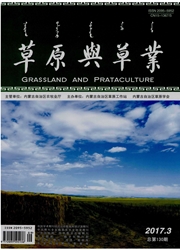

 中文摘要:
中文摘要:
以短花针茅草原为研究对象,设置5个放牧强度季节调控试验处理和1个对照处理,对不同放牧处理土壤的理化性质进行研究。结果表明,放牧对土壤的物理性质影响较为明显,土壤容重随着放牧强度的增加而显著升高(P〈0.05),全年重牧土壤容重上升较明显;土壤含水量随放牧强度的增加而降低,其中,全年重牧土壤的0~20 cm土层下降显著(P〈0.05)。各放牧处理对0~20 cm以及30~40 cm土层土壤有机质含量影响不显著(P〉0.05),对10~40 cm土层土壤全氮和速效氮含量影响不显著(P〉0.05),春季零放牧+夏季重牧+秋季适牧处理土壤的0~10 cm土层速效氮含量显著提高(P〈0.05);春季零放牧+夏季重牧+秋季适牧处理土壤的10~20 cm土层全磷含量显著升高(P〈0.05),其他土层在不同放牧处理下变化不显著(P〉0.05);各放牧处理对土壤速效磷和全钾含量的影响不显著(P〉0.05),对0~20 cm土壤速效钾含量的影响不显著(P〉0.05)。综合各项理化性质指标,春季零放牧+夏季重牧+秋季适牧是最佳的草地利用方式。
 英文摘要:
英文摘要:
In the present study, five seasonal regulation of grazing intensity treatments and one control treatment were set to assess the response of soil physical and chemical properties to seasonal regulation of grazing intensity in Stipa breviflora steppe. The results revealed that grazing had obvious impact on soil physical properties: the soil bulk density was significantly increased with the increase of grazing intensity (P〈0.05), especially in the whole-year heavily grazed soil; the soil moisture was decreased with the increase of grazing intensity and the statistically significant reduction was observed in 0-20 cm layer of the whole-year heavily grazed soil (P〈0.05). Different grazing treatments had no significant impact on soil organic matter content of 0-20 cm and 30-40 cm soil layer (P〉0.05), and had no significant impact on soil total nitrogen and available nitrogen content of 10-d0 cm soil layer (P〉0.05); for the treatment of no grazing in spring + heavy grazing in summer + moderate grazing in autumn, the soil available nitrogen content of 0-10 cm soil layer was significantly increased (P〈0.05); the total phosphorus content of 10-20 cm soil layer in the above mentioned treatment was significantly increased (P〈0.05), but no significant differences in soil total phosphorus content in the other soil layers between the different grazing treatments were observed (P〉0.05); grazing had no significant impact on soil available phosphorus and total potassium content (P〉0.05), and had no significant impact on soil available potassium content of 0-20 cm soil layer (P〉0.05). The combined data demonstrate that the grazing intensity seasonal regulation mode of no grazing in spring + heavy grazing in summer + moderate grazing in autumn is the optimum utilization pattern of Stipa breviflora steppe.
 同期刊论文项目
同期刊论文项目
 同项目期刊论文
同项目期刊论文
 期刊信息
期刊信息
